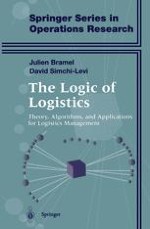This book grew out a number of distribution and logistics graduate courses we have taught over the last ten years. In the first few years, the emphasis was on very basic models such as the traveling salesman problem, and on the seminal papers of Haimovich and Rinnooy Kan (1985), which analyzed a simple vehicle routing problem, and Roundy (1985), which introduced power-of-two policies and proved that they are effective for the one warehouse multi-retailer distribution system. At that time, few results existed for more complex, realistic distribution problems, stochastic inventory problems or the integration of these issues. In the last few years however, there has been renewed interest in the area of logistics among both industry and academia. A number of forces have contributed to this shift. First, industry has realized the magnitude of savings that can be achieved by better planning and management of complex logistics systems. In deed, a striking example is Wal-Mart's success story which is partly attributed to implementing a new logistics strategy, called cross-docking. Second, advances in information and communication technologies together with sophisticated decision support systems now make it possible to design, implement and control logistics strategies that reduce system-wide costs and improve service level. These decision support systems, with their increasingly user-friendly interfaces, are fundamentally changing the management of logistics systems.
